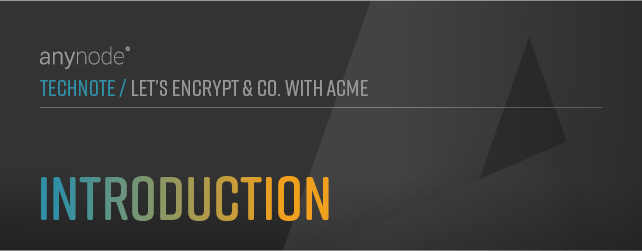
Introduction
This training focuses on how to use Let's Encrypt & Co. with ACME and anynode – The Software SBC to manage and update certificates easily.
Review the chapter overview for a simplified guide on certificate management with Let's Encrypt and various other certification issuance providers in anynode - The Software SBC.
This guide focuses on how to use Let's Encrypt & Co. with ACME and anynode – The Software SBC to manage and update certificates easily.
To ensure that certificates already in use remain valid, regular verification and often manual updating are required. With the integration of Let's Encrypt and other ACME services, anynode provides easy certificate management with automation capabilities for continuous certificate updates – for both new and existing configurations alike. Certificates are acquired and managed using the ACME protocol (Automatic Certificate Management Environment).
Trusted certificates can be generated directly in anynode’s frontend and automatically renewed when needed. When using certain certification authorities such as Let's Encrypt or Zero SSL, this can even be done without incurring additional costs.
The chapters of this guide will provide step-by-step explanations for the configuration, which include the following steps:
-
In the Create Node with ACME chapter, we will take care of how to configure a node with a certification issuance provider. We will perform this using the example of a Microsoft Teams Direct Routing node. In doing so, we will delve into the unique characteristics of the available certification issuance providers: Let's Encrypt, ZeroSSL, and GoDaddy.
-
In the Configure existing Node with ACME chapter, we will guide you on how to retroactively equip an existing configuration with an ACME certificate retrieval for a pre-existing node. Once again, we will explore the specific features of the available certification issuance providers: Let's Encrypt, ZeroSSL, and GoDaddy.
-
The Certificate Validation in Dashboard chapter illustrates the verification of a node's proper functionality within the anynode dashboard using the example of Microsoft Teams Direct Routing. We will also outline the verification status for confirming the correct certificate retrieval within the anynode dashboard.
-
Moving on to the Certificate Issuance chapter, our primary focus will be on the processes involved in renewing, modifying, or removing certificates. You can choose between connecting to one of the listed certification issuance providers or manually entering the URL.
-
In the Create HTTPS Connector with ACME chapter, we will explore how to add an HTTP connector. The HTTPS connector is desired to enable external access to the anynode frontend
-
Concluding the documentation, the Other ACME Provider chapter outlines the utilization of an alternative certification issuance provider, distinct from Let's Encrypt, ZeroSSL, or GoDaddy.
By the end of this guide, we'll have a comprehensive understanding of how to manage and update certificates using anynode – The Software SBC.
The documentation, screenshots, and configuration examples in this document are based on anynode version 4.10.
We'd like to clarify that the terminologies used in the anynode frontend, including certification issuance provider, certificate issuance provider, ACME provider, and ACME service, all pertain to automated certificate authorities such as Let's Encrypt & Co. and compatible services.
To find information and documentation related to anynode, check our websites anynodesbc.com and TE-SYSTEMS Community.